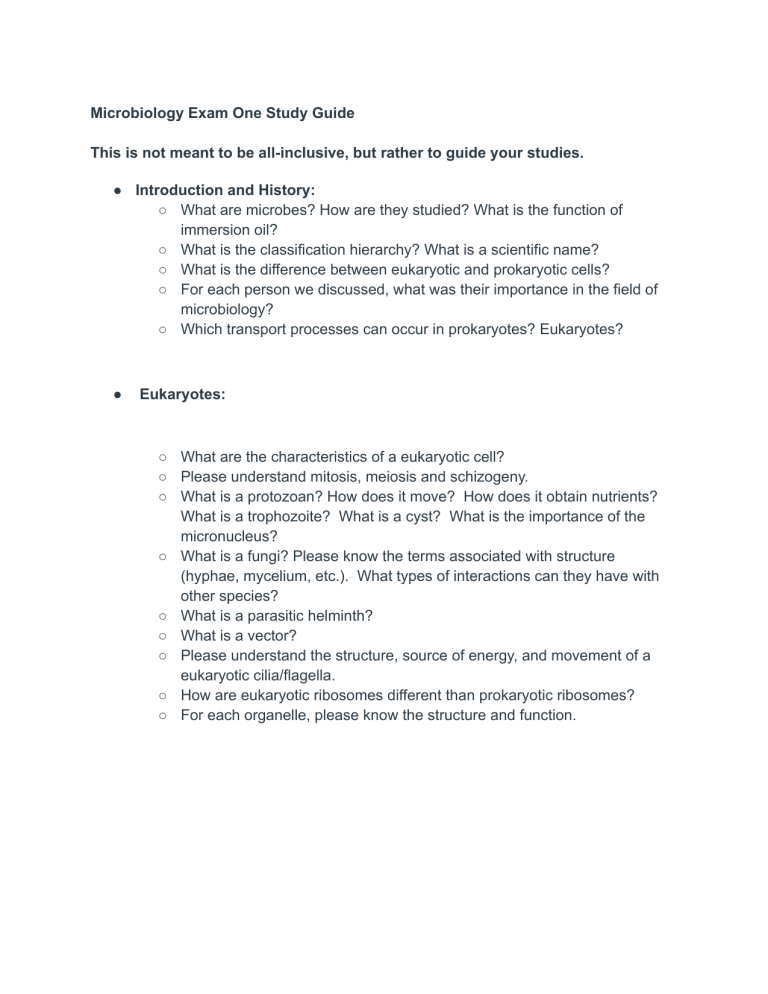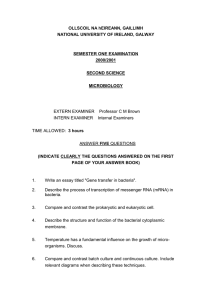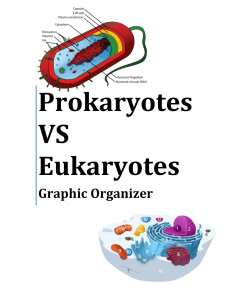
Microbiology Exam One Study Guide This is not meant to be all-inclusive, but rather to guide your studies. ● Introduction and History: ○ What are microbes? How are they studied? What is the function of immersion oil? ○ What is the classification hierarchy? What is a scientific name? ○ What is the difference between eukaryotic and prokaryotic cells? ○ For each person we discussed, what was their importance in the field of microbiology? ○ Which transport processes can occur in prokaryotes? Eukaryotes? ● Eukaryotes: ○ What are the characteristics of a eukaryotic cell? ○ Please understand mitosis, meiosis and schizogeny. ○ What is a protozoan? How does it move? How does it obtain nutrients? What is a trophozoite? What is a cyst? What is the importance of the micronucleus? ○ What is a fungi? Please know the terms associated with structure (hyphae, mycelium, etc.). What types of interactions can they have with other species? ○ What is a parasitic helminth? ○ What is a vector? ○ Please understand the structure, source of energy, and movement of a eukaryotic cilia/flagella. ○ How are eukaryotic ribosomes different than prokaryotic ribosomes? ○ For each organelle, please know the structure and function. ● Prokaryotes: ○ What are the characteristics of a bacterial cell? ○ Please understand the structure, classifications, source of energy, and movement of a prokaryotic flagella. ○ Which organism would contain axial filaments? ○ What is the purpose of fimbriae and pili? ○ What are the functions of a glycocalyx? How is a slime layer different than a capsule? ○ Please know the details of gram positive and gram negative cell walls. How are flagella attached in each? ○ What does the typical genome a bacterial cell look like? What is a plasmid? ○ What are the seven types of inclusion bodies, and what are each used for in the cell? ○ When would an endospore form? What is the function? ○ What sets Archaea apart from modern bacteria? ● ● Microbial Nutrition and Growth: ○ Please understand the terms that refer to optimal growth temperatures. ○ What are macronutrients and micronutrients? ○ How are bacteria classified in terms of oxygen? ○ Please know the terms used in nutritional patterns. ○ What is the growth curve? What is happening at each step? ○ Please know the equation for growth, and how to calculate growth. ○ What is the advantage of living in a biofilm for a bacteria? Why are these of medical importance? ○ What are the two methods we used in lab to separate out species from a mixture? ○ What is the difference between a differential media and a selective media? ● Viruses and Prions: ○ What are the general characteristics of a virion? Is it alive? ○ What types of genomes are possible in virions? ○ What determines a host range? ○ Please understand the morphologies of viruses. ○ For the bacteriophages; What are the steps in the lytic cycle? Why is lysozyme important? What is a prophage in the lysogenic cycle? What are results of lysogeny? ○ For an animal virus; What are the modes of entry? What is uncoating? What is budding? ○ How are viruses cultured? ○ How do viruses cause cancer? Please know proto-oncogene, oncogene, tumor suppressor gene. ○ What is the difference between latent and chronic viral infections? ○ Please know the 5 categories of antiviral medications and what each does in general. ○ What are prions, how do they cause disease? Please know the names of the diseases these can cause.







